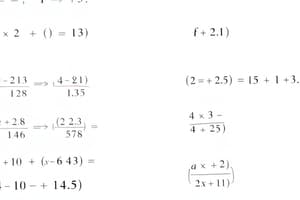Podcast
Questions and Answers
What is the first step in using factoring to solve a quadratic equation?
What is the first step in using factoring to solve a quadratic equation?
- Rewriting the quadratic equation in standard form. (correct)
- Finding the roots of the equation.
- Identifying the coefficients a, b, and c.
- Setting the linear factors equal to zero.
For the quadratic equation x² + 5x + 6 = 0, what are the factors?
For the quadratic equation x² + 5x + 6 = 0, what are the factors?
- (x + 1)(x + 6)
- (x + 3)(x + 2) (correct)
- (x - 2)(x - 3)
- (x + 2)(x + 5)
What is the result when a quadratic equation is expressed as a difference of squares?
What is the result when a quadratic equation is expressed as a difference of squares?
- It results in a complex number.
- It remains unfactorable.
- It gives one linear factor only.
- It factors into two binomials. (correct)
What should you look for in a perfect square trinomial?
What should you look for in a perfect square trinomial?
When the leading coefficient a is not equal to 1, what method can be used for factoring?
When the leading coefficient a is not equal to 1, what method can be used for factoring?
If a quadratic equation can be factored as (x + p)(x + q) = 0, what is true about p and q?
If a quadratic equation can be factored as (x + p)(x + q) = 0, what is true about p and q?
In the equation 2x² + 8x + 6 = 0, what is the first step in factoring?
In the equation 2x² + 8x + 6 = 0, what is the first step in factoring?
For the quadratic equation x² - 16 = 0, what is the factored form?
For the quadratic equation x² - 16 = 0, what is the factored form?
Công thức bậc hai được sử dụng để tìm giá trị nào trong phương trình bậc hai ax² + bx + c = 0?
Công thức bậc hai được sử dụng để tìm giá trị nào trong phương trình bậc hai ax² + bx + c = 0?
Trong công thức bậc hai, biểu thức b² - 4ac được gọi là gì?
Trong công thức bậc hai, biểu thức b² - 4ac được gọi là gì?
Nếu định thức b² - 4ac trong phương trình bậc hai là âm, thì điều gì sẽ xảy ra với các nghiệm của phương trình?
Nếu định thức b² - 4ac trong phương trình bậc hai là âm, thì điều gì sẽ xảy ra với các nghiệm của phương trình?
Khi sử dụng công thức bậc hai, điểm nào là quan trọng nhất trong quá trình giải?
Khi sử dụng công thức bậc hai, điểm nào là quan trọng nhất trong quá trình giải?
Cho phương trình bậc hai x² - 5x - 6 = 0, giá trị của a trong công thức là bao nhiêu?
Cho phương trình bậc hai x² - 5x - 6 = 0, giá trị của a trong công thức là bao nhiêu?
Kết quả của nghiệm phương trình bậc hai sẽ như thế nào nếu hệ số a trong công thức bậc hai bằng 0?
Kết quả của nghiệm phương trình bậc hai sẽ như thế nào nếu hệ số a trong công thức bậc hai bằng 0?
Biểu thức nào trong công thức bậc hai xác định số nghiệm của phương trình?
Biểu thức nào trong công thức bậc hai xác định số nghiệm của phương trình?
Khi nào thì phương trình bậc hai có một nghiệm duy nhất?
Khi nào thì phương trình bậc hai có một nghiệm duy nhất?
Flashcards
Simple Trinomial Factoring
Simple Trinomial Factoring
Factoring quadratic equations of the form x² + bx + c = 0 by finding two numbers that multiply to 'c' and add up to 'b'.
Difference of Squares
Difference of Squares
Factoring quadratic equations in the form x² - c² = 0 into (x + c)(x - c) = 0.
Perfect Square Trinomial
Perfect Square Trinomial
A quadratic in the form x² + 2bx + b² = 0, factors as (x + b)² = 0.
Quadratic Equation
Quadratic Equation
Signup and view all the flashcards
Factoring with a ≠ 1
Factoring with a ≠ 1
Signup and view all the flashcards
Zero-Product Property
Zero-Product Property
Signup and view all the flashcards
Standard Form
Standard Form
Signup and view all the flashcards
Grouping
Grouping
Signup and view all the flashcards
Phương trình bậc hai là gì?
Phương trình bậc hai là gì?
Signup and view all the flashcards
Nghiệm của phương trình bậc hai
Nghiệm của phương trình bậc hai
Signup and view all the flashcards
Phân tích thành nhân tử
Phân tích thành nhân tử
Signup and view all the flashcards
Hoàn thành bình phương
Hoàn thành bình phương
Signup and view all the flashcards
Công thức bậc hai
Công thức bậc hai
Signup and view all the flashcards
Biệt thức (Δ)
Biệt thức (Δ)
Signup and view all the flashcards
Δ > 0
Δ > 0
Signup and view all the flashcards
Δ = 0
Δ = 0
Signup and view all the flashcards
Study Notes
Factoring Methods for Quadratic Equations
- Factoring is a powerful technique for solving quadratic equations of the form ax² + bx + c = 0, where a, b, and c are constants.
- The core idea is to rewrite the quadratic expression as a product of two linear factors.
- Successful factoring usually demands understanding the relationship between the coefficients (a, b, and c) and the factors of 'c'.
Common Factoring Techniques
-
Simple Trinomial Factoring (a = 1):
- If the quadratic equation is in the form x² + bx + c = 0, you need to find two numbers that multiply to 'c' and add up to 'b'.
- These numbers represent the coefficients of the linear terms in the factored form (x + p)(x + q), where p and q are the numbers found.
- Example: x² + 5x + 6 = 0 factors to (x + 2)(x + 3) = 0, yielding solutions x = -2 and x = -3.
-
Grouping:
- Sometimes, a quadratic with a = 1 is solved by grouping terms.
- This method is particularly useful if the quadratic is a sum of two binomials and cannot be factored neatly.
-
Difference of Squares:
- If a quadratic equation can be expressed as x² – c² = 0, it factors to (x + c)(x – c) = 0.
- This yields solutions x = c and x = -c.
- Example: x² - 9 = 0 factors to (x + 3)(x - 3) = 0, with solutions x = 3 and x = -3.
-
Perfect Square Trinomials:
- Recognising a perfect square trinomial helps solve quadratic equations efficiently.
- It has the form x² + 2bx + b² = (x + b)², solving to x= -b.
- Example: x² + 6x + 9 = 0 factors to (x + 3)² = 0, giving a single solution x = -3.
-
Factoring with a ≠ 1:
- When a is not equal to 1, the process becomes more complex requiring more strategies. One approach is trial and error, systematically evaluating different factor pairs.
- A more systematic procedure might involve the AC method (multiply a and c).
- Example: 2x² + 5x + 3 = 0 factors to (2x + 3)(x + 1) = 0, which yields solutions x = -3/2 and x = -1.
Steps to Solve Using Factoring:
- Rewriting: Rewrite the quadratic equation in standard form (ax² + bx + c = 0).
- Factoring: Factor the quadratic expression into two linear factors.
- Setting to Zero (Zero-Product Property): Set each linear factor equal to zero.
- Solving for x: Solve each resulting linear equation for x to find the solutions to the original quadratic equation.
Identifying Perfect Square Trinomials & Difference of Squares
- Perfect Square Trinomials: Have the form a²x² ± 2abx + b² (important note: the ± sign can be either plus or minus) which factors into (ax ± b)².
- Difference of Squares: This pattern is recognizable with two perfect squares and a subtraction sign. This is essential for efficiently solving certain quadratics leading to a straightforward solution.
Importance of Factoring
- Factoring is crucial for solving quadratic equations efficiently and accurately.
- It helps in understanding the relationship between solutions and the quadratic expression structure.
- It forms a foundation for various other mathematical concepts.
Studying That Suits You
Use AI to generate personalized quizzes and flashcards to suit your learning preferences.




